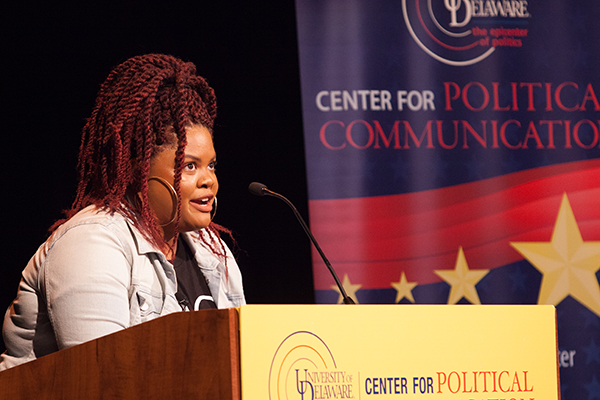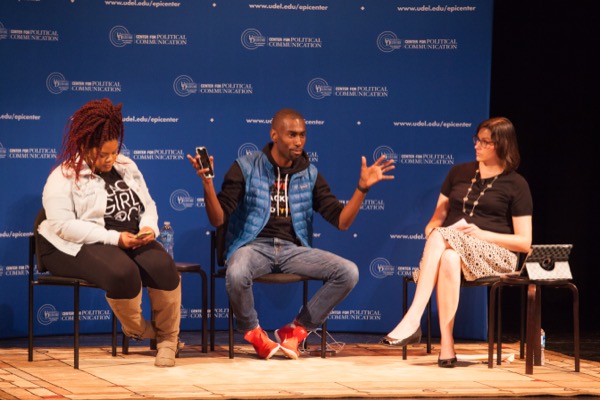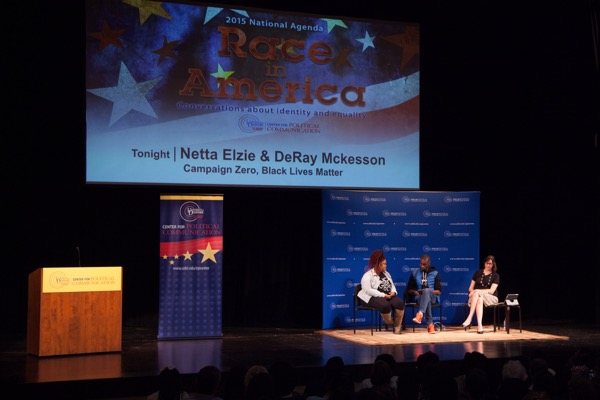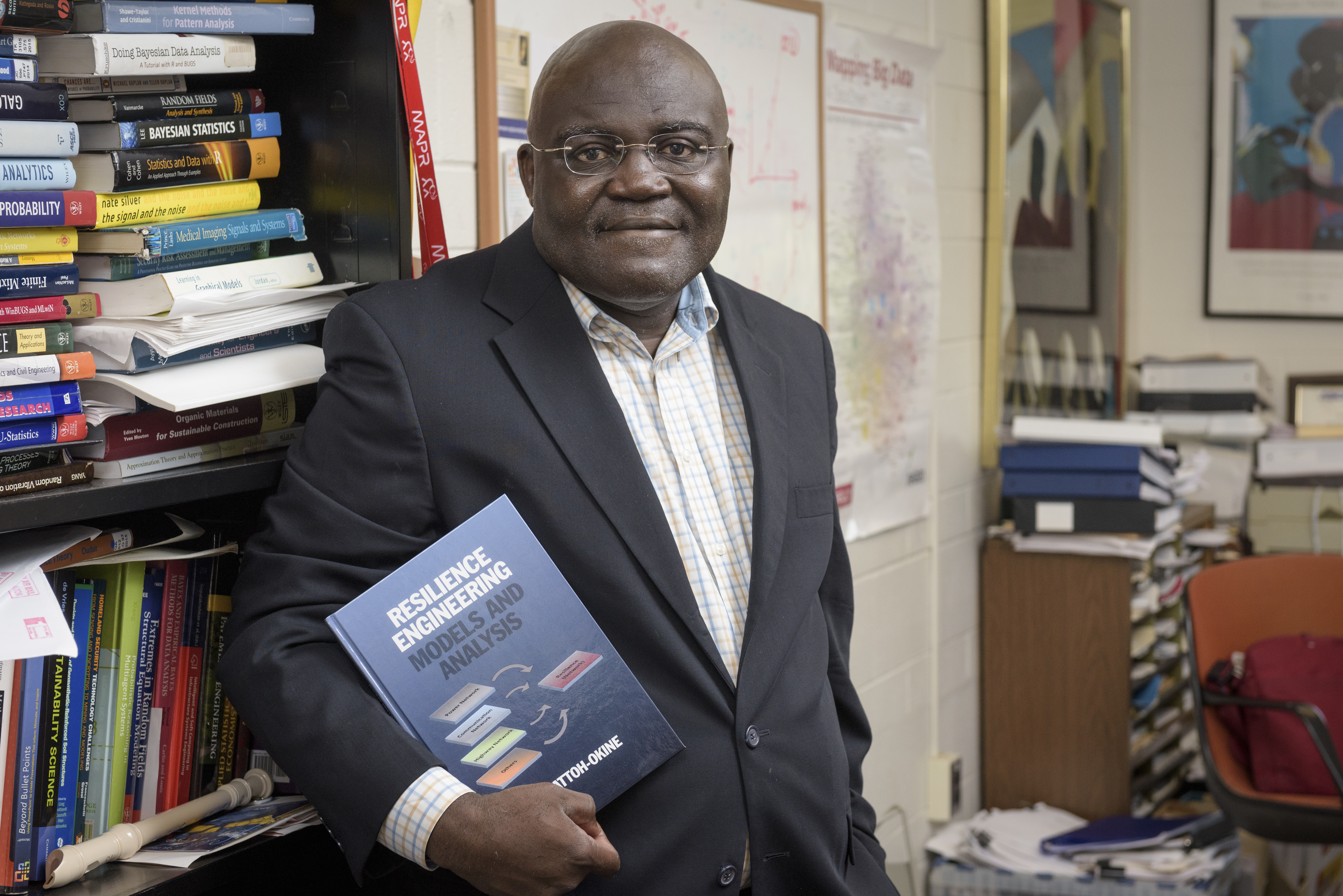

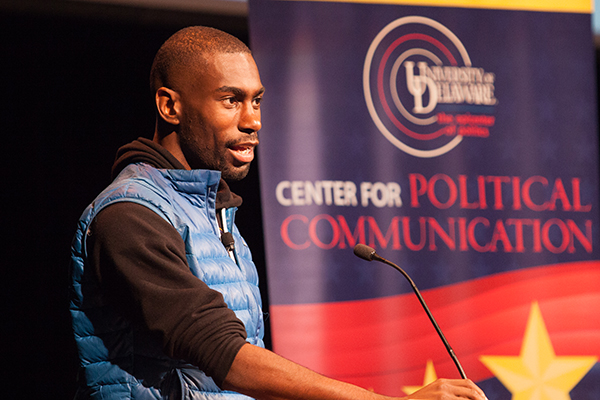
National Agenda: Telling the story
Grassroots participation, social media key to Black Lives Matter movement
2:22 p.m., Oct. 1, 2015--Social media has provided a new space for honest conversations about race, a platform through which to organize and a means by which to bear witness to the pain of the black community resulting from killings at the hands of the authorities, two Black Lives Matter activists told a large University of Delaware National Agenda speaker series audience on Wednesday night, Sept. 30, in Mitchell Hall.
The presentation featured Johnetta (Netta) Elzie, who provided an emotional account of her decision to work in the movement, and DeRay Mckesson. Both were recognized among Fortune Magazine’s world’s 50 greatest leaders this year and both received the 2015 Howard Zinn Freedom to Write Award for their work.
People Stories
'Resilience Engineering'
Reviresco June run
They recently launched the We the Protesters and Campaign Zero sites, the latter promoting an end to police violence in the United States.
Mckesson, a Teach for America alumnus, said Black Lives Matter was built from the ground up rather than the top down. Following the shooting death of Michael Brown in Ferguson, Missouri, “People came out and made the movement,” he said.
Twitter provided a democratic means of sharing news about this and other shootings of black youths, bypassing traditional media to discuss the trauma of racism. Given that there was no culture of questioning police, Mckesson said that “either our story was never told, or it was told by everyone but us.”
“If not for Twitter, they would have convinced you we did not exist,” he said.
The last two radical spaces in America, Mckesson said, are Twitter and the classroom. To be heard via social media, all one needs is a phone, he said, adding that the classroom should be used to push people to grow and to change the way people talk about race on campus.
Elzie, who is from St. Louis, joined the Black Lives Matter movement after the shooting in Ferguson when she found the conversation – and images of Brown’s body in the street -- on Twitter. It struck a nerve because a friend, Stephon Averthart, had earlier been shot and killed by police.
“I stepped out of my personal shell into the world,” she said. “I didn’t fight for Stephon, so I felt I had to fight for this boy I didn’t know.”
Despite opposition within her family – her grandmother had seen the violence in Little Rock, Arkansas, during the civil rights movement – Elzie said she felt she couldn’t just walk away.
Participation, however, meant putting herself on the line. She stood in front of an armored truck and was chased by the National Guard, yet found her purpose.
The oft-heard chant is true, she said: “Without justice, we can’t have peace. If there is no justice, there will be no peace.”
In a just world, no one is traumatized, Elzie said, adding that it is imperative that changes are made to a system that harms.
Questions and answers
The presentation was moderated by Lindsay Hoffman, associate professor in UD’s Department of Communication, associate director of the Center for Political Communication and director of the series, who accepted questions from the audience and from people following online.
Concerning recent events at UD, Mckesson discussed what students on campus can do to feel accepted, saying that it is important to have conversations that are not only based around traumatic events. Conservations around race should be a core component of the education, he said.
Black Lives Matter has provided a platform through which to reach out to current presidential candidates and Mckesson said he believes many politicians are too timid when it comes to using the “bully pulpit” to discuss race, violence and structural inequities in America.
Asked how they maintain hope in a troubling world, Elzie said she often copes by crying and, citing James Baldwin, tries to use her “perpetual state of rage” to accomplish something substantial and to create change.
For her, Elzie said, “It’s freedom or nothing.”
Mckesson said it is important to believe that the tomorrows will be better than the todays, and to keep battling even though institutions are designed to wait you out.
Looking to the future, he said those in the movement must develop a way to fashion the fight so that people of every stage of life can participate.
About the series
The 2015 National Agenda series includes six speakers and four films designed to stimulate conversations about equality and identity, all scheduled at 7:30 p.m. on Wednesdays in Mitchell Hall on the UD campus in Newark. Presentations are free and open to the public.
The director of the series is Lindsay Hoffman, associate director of UD's Center for Political Communication.
National Agenda includes both speakers and films. The next film screening will be Mississippi Burning on Oct. 7, and the next speaker will be journalist Peter Bailey on Oct. 14.
National Agenda is supported by the College of Arts and Sciences, the Office of the Provost, the Center for the Study of Diversity and the William P. Frank Foundation of Delaware.
Photos by Ambre Alexander Payne




